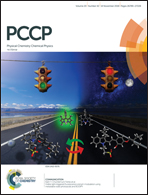Spin density distributions on graphene clusters and ribbons with carbene-like active sites
Abstract
Aiming to better understand the reactivity of graphene-based materials, the present work employs density functional theory that provides detailed information about spin-density distributions for single and contiguous pairs of carbene-like active sites. In order to examine the extent to which different models, methodologies, and approximations affect the outcome, our calculations employ the AIMPRO, QuantumEspresso and Gaussian program packages. Models are in the form of polycyclic aromatic hydrocarbons (PAHs) and graphene nanoribbons (GNRs), both isolated and within supercells with periodic boundary conditions. Benchmarking calculations for the phenyl radical and cation are also presented. General agreement is found among the methods and also with previous studies. A significant electron spin polarization (spin density >1.096 electron spin) on the active sites is seen in both periodic and cluster systems, but it tends to be lower for GNRs than graphene clusters. The effect of the functional seems to be much more important than the position of singularities at the edges of the GNRs. Finally, we show the interactions and effects on spin density when a single site lies at the edge of a bilayer GNR, where bonding between layers may occur under specific circumstances.



 Please wait while we load your content...
Please wait while we load your content...